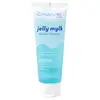What's inside
What's inside
 Key Ingredients
Key Ingredients

 Benefits
Benefits

 Concerns
Concerns

 Ingredients Side-by-side
Ingredients Side-by-side

Water
Skin ConditioningGlycerin
HumectantCocamidopropyl Hydroxysultaine
CleansingSodium Cocoyl Isethionate
CleansingSodium Methyl Cocoyl Taurate
CleansingSodium Chloride
MaskingSodium Hydrolyzed Potato Starch Dodecenylsuccinate
Potassium Acrylates Copolymer
Hydroxyacetophenone
AntioxidantPhenoxyethanol
PreservativeLinoleamidopropyl Pg-Dimonium Chloride Phosphate
Polyquaternium-10
Sodium Hydroxide
BufferingDisodium EDTA
Citric Acid
BufferingEthylhexylglycerin
Skin ConditioningHydrolyzed Hyaluronic Acid
HumectantWater, Glycerin, Cocamidopropyl Hydroxysultaine, Sodium Cocoyl Isethionate, Sodium Methyl Cocoyl Taurate, Sodium Chloride, Sodium Hydrolyzed Potato Starch Dodecenylsuccinate, Potassium Acrylates Copolymer, Hydroxyacetophenone, Phenoxyethanol, Linoleamidopropyl Pg-Dimonium Chloride Phosphate, Polyquaternium-10, Sodium Hydroxide, Disodium EDTA, Citric Acid, Ethylhexylglycerin, Hydrolyzed Hyaluronic Acid
Water
Skin ConditioningAcrylates Copolymer
Cocamidopropyl Betaine
CleansingCocamide DEA
EmulsifyingPotassium Cocoyl Glycinate
Disodium Laureth Sulfosuccinate
CleansingGlycerin
HumectantSodium Chloride
MaskingSodium Lauryl Sulfoacetate
CleansingPhenoxyethanol
PreservativeCaprylyl Glycol
EmollientSodium Hydroxide
BufferingNymphaea Tetragona Extract
Skin ConditioningLactobacillus
Skin ConditioningNelumbo Nucifera Extract
Skin ConditioningLactobacillus/Portulaca Oleracea Ferment Extract
AntioxidantPhellinus Linteus/Rice Ferment Extract
EmollientSantalum Album Wood Extract
PerfumingVelvet Extract
HumectantCordyceps Sinensis Extract
AntioxidantHouttuynia Cordata Extract
Skin ConditioningCamellia Sinensis Leaf Extract
AntimicrobialPanax Ginseng Root Extract
EmollientLonicera Japonica Flower Extract
Skin ConditioningCentella Asiatica Extract
CleansingAstragalus Membranaceus Root Extract
EmollientCnidium Officinale Root Extract
Skin ConditioningGlycyrrhiza Uralensis Root Extract
Skin ConditioningDisodium EDTA
CI 42090
Cosmetic ColorantParfum
MaskingButylphenyl Methylpropional
PerfumingHexyl Cinnamal
PerfumingLinalool
PerfumingWater, Acrylates Copolymer, Cocamidopropyl Betaine, Cocamide DEA, Potassium Cocoyl Glycinate, Disodium Laureth Sulfosuccinate, Glycerin, Sodium Chloride, Sodium Lauryl Sulfoacetate, Phenoxyethanol, Caprylyl Glycol, Sodium Hydroxide, Nymphaea Tetragona Extract, Lactobacillus, Nelumbo Nucifera Extract, Lactobacillus/Portulaca Oleracea Ferment Extract, Phellinus Linteus/Rice Ferment Extract, Santalum Album Wood Extract, Velvet Extract, Cordyceps Sinensis Extract, Houttuynia Cordata Extract, Camellia Sinensis Leaf Extract, Panax Ginseng Root Extract, Lonicera Japonica Flower Extract, Centella Asiatica Extract, Astragalus Membranaceus Root Extract, Cnidium Officinale Root Extract, Glycyrrhiza Uralensis Root Extract, Disodium EDTA, CI 42090, Parfum, Butylphenyl Methylpropional, Hexyl Cinnamal, Linalool
Ingredients Explained
These ingredients are found in both products.
Ingredients higher up in an ingredient list are typically present in a larger amount.
Disodium EDTA plays a role in making products more stable by aiding other preservatives.
It is a chelating agent, meaning it neutralizes metal ions that may be found in a product.
Disodium EDTA is a salt of edetic acid and is found to be safe in cosmetic ingredients.
Learn more about Disodium EDTAGlycerin is already naturally found in your skin. It helps moisturize and protect your skin.
A study from 2016 found glycerin to be more effective as a humectant than AHAs and hyaluronic acid.
As a humectant, it helps the skin stay hydrated by pulling moisture to your skin. The low molecular weight of glycerin allows it to pull moisture into the deeper layers of your skin.
Hydrated skin improves your skin barrier; Your skin barrier helps protect against irritants and bacteria.
Glycerin has also been found to have antimicrobial and antiviral properties. Due to these properties, glycerin is often used in wound and burn treatments.
In cosmetics, glycerin is usually derived from plants such as soybean or palm. However, it can also be sourced from animals, such as tallow or animal fat.
This ingredient is organic, colorless, odorless, and non-toxic.
Glycerin is the name for this ingredient in American English. British English uses Glycerol/Glycerine.
Learn more about GlycerinPhenoxyethanol is a preservative that has germicide, antimicrobial, and aromatic properties. Studies show that phenoxyethanol can prevent microbial growth. By itself, it has a scent that is similar to that of a rose.
It's often used in formulations along with Caprylyl Glycol to preserve the shelf life of products.
Chances are, you eat sodium chloride every day. Sodium Chloride is also known as table salt.
This ingredient has many purposes in skincare: thickener, emulsifier, and exfoliator.
You'll most likely find this ingredient in cleansers where it is used to create a gel-like texture. As an emulsifier, it also prevents ingredients from separating.
There is much debate on whether this ingredient is comedogenic. The short answer - comedogenic ratings don't tell the whole story. Learn more about comegodenic ratings here.
The concensus about this ingredient causing acne seems to be divided. Research is needed to understand if this ingredient does cause acne.
Scrubs may use salt as the primary exfoliating ingredient.
Learn more about Sodium ChlorideSodium Hydroxide is also known as lye or caustic soda. It is used to adjust the pH of products; many ingredients require a specific pH to be effective.
In small amounts, sodium hydroxide is considered safe to use. However, large amounts may cause chemical burns due to its high alkaline.
Your skin has a natural pH and acid mantle. This acid mantle helps prevent harmful bacteria from breaking through. The acid mantle also helps keep your skin hydrated.
"Alkaline" refers to a high pH level. A low pH level would be considered acidic.
Learn more about Sodium HydroxideWater. It's the most common cosmetic ingredient of all. You'll usually see it at the top of ingredient lists, meaning that it makes up the largest part of the product.
So why is it so popular? Water most often acts as a solvent - this means that it helps dissolve other ingredients into the formulation.
You'll also recognize water as that liquid we all need to stay alive. If you see this, drink a glass of water. Stay hydrated!
Learn more about Water